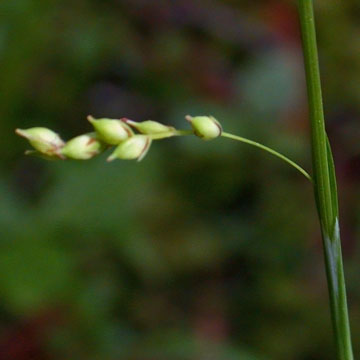

Carex vaginata - (image 1 of 2)
Taxonomy
Family: Cyperaceae
Section Paniceae
Habitat
Calcareous swamps, wet thickets.
Associates
Distribution
Circumboreal, south in North America to ME, northern NY, northern MI, northern MN, Saskatchewan, and British Columbia.
Morphology
Perennial from long rhizomes; stems 20-60 cm, few together, phyllopodic; main leaves 2-5 mm wide; terminal spike staminate, 1-2 cm; pistillate spikes 1-3, often staminate at the tip, rather loosely spreading, widely separated, the lower peduncles elongate, the upper shorter; bracts with loose sheaths 1-2 cm and short blades shorter than the spikes; pistillate scales shorter and narrower than the perigynia, purplish-brown, with or without a narrow green midstrip, usually acute; perigynia usually in 2 rows, the lower separated by internodes 2-5 mm, the upper somewhat overlapping, glabrous, 2-keeled, obscurely nerved, 3.5-5 mm, fusiform-obovoid, with a somewhat outcurved beak about 1 mm long; achene obovoid-trigonous with concave sides, nearly filling the perigynium.
Notes
Fruiting late May to July
Wetland indicator: OBL
This species differs from other members of section Paniceae in that it lacks papillae on the lower leaf surface, peduncles, and perigynia. North American plants are sometimes considered a separate species, C. saltuensis L.H. Bailey.
References
Ball, P.W. and A.A. Reznicek. 2002. Carex, In: Flora of North America Editorial Committee, Eds. Flora of North America North of Mexico. Volume 23. Oxford University Press, New York.
Gleason, Henry A. and A. Cronquist. 1991. Manual of Vascular Plants of
Northeastern United States and Adjacent Canada. Second Ed.
The New York Botanical Garden. Bronx, NY
|
© Michael Hough 2018 |